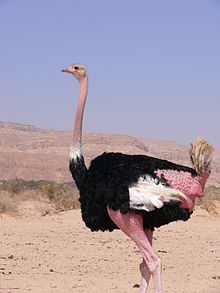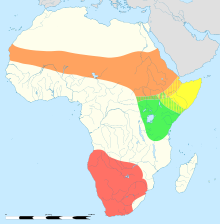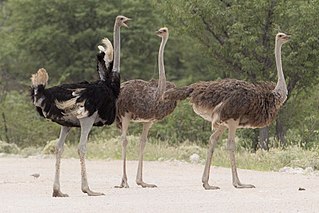
The common ostrich, or simply ostrich, is a species of flightless bird native to certain large areas of Africa. It is one of two extant species of ostriches, the only living members of the genus Struthio in the ratite order of birds. The other is the Somali ostrich, which was recognized as a distinct species by BirdLife International in 2014 having been previously considered a distinctive subspecies of ostrich.

Struthionidae is a family of flightless birds, containing the extant ostriches and their extinct relatives. The two extant species of ostrich are the common ostrich and Somali ostrich, both in the genus Struthio, which also contains several species known from Holocene fossils such as the Asian ostrich. The common ostrich is the more widespread of the two living species, and is the largest living bird species. The extinct genus Pachystruthio from the Late Pliocene-Early Pleistocene of Eurasia is one of the largest birds ever.
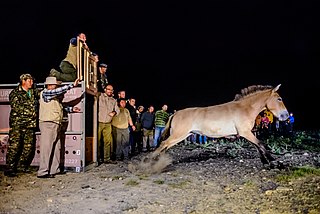
Species reintroduction is the deliberate release of a species into the wild, from captivity or other areas where the organism is capable of survival. The goal of species reintroduction is to establish a healthy, genetically diverse, self-sustaining population to an area where it has been extirpated, or to augment an existing population. Species that may be eligible for reintroduction are typically threatened or endangered in the wild. However, reintroduction of a species can also be for pest control; for example, wolves being reintroduced to a wild area to curb an overpopulation of deer. Because reintroduction may involve returning native species to localities where they had been extirpated, some prefer the term "reestablishment".
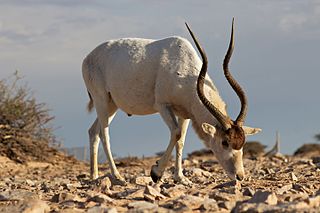
The addax, also known as the white antelope and the screwhorn antelope, is an antelope native to the Sahara Desert. The only member of the genus Addax, it was first described scientifically by Henri de Blainville in 1816. As suggested by its alternative name, the pale antelope has long, twisted horns – typically 55 to 80 cm in females and 70 to 85 cm in males. Males stand from 105 to 115 cm at the shoulder, with females at 95 to 110 cm. They are sexually dimorphic, as the females are smaller than the males. The colour of the coat depends on the season – in the winter, it is greyish-brown with white hindquarters and legs, and long, brown hair on the head, neck, and shoulders; in the summer, the coat turns almost completely white or sandy blonde.

Flightless birds are birds that, through evolution, lost the ability to fly. There are over 60 extant species, including the well-known ratites and penguins. The smallest flightless bird is the Inaccessible Island rail. The largest flightless bird, which is also the largest living bird in general, is the common ostrich.
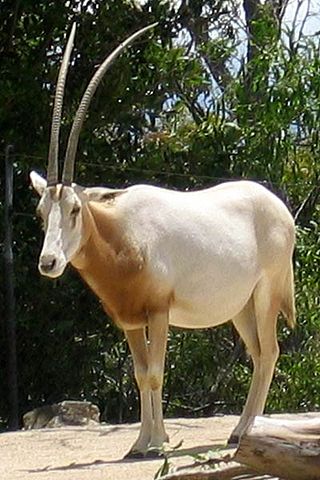
The scimitar oryx, also known as the scimitar-horned oryx and the Sahara oryx, is an Oryx species that was once widespread across North Africa. In 2000, it was declared extinct in the wild on the IUCN Red List. This particular oryx is adapted to harsh desert conditions and can survive for months or even years without drinking water. A grazing animal, it derives most of its daily moisture intake from plants.

Ostriches are large flightless birds. They are the heaviest and largest living birds, with adult common ostriches weighing anywhere between 63.5 and 145 kilograms and laying the largest eggs of any living land animal. With the ability to run at 70 km/h (43.5 mph), they are the fastest birds on land. They are farmed worldwide, with significant industries in the Philippines and in Namibia. Ostrich leather is a lucrative commodity, and the large feathers are used as plumes for the decoration of ceremonial headgear. Ostrich eggs have been used by humans for millennia.
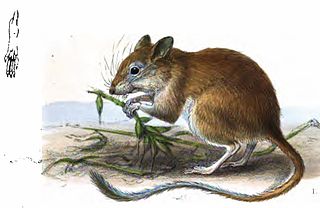
The Balochistan gerbil or dwarf gerbil, is distributed mainly from Morocco across north Africa, the Arabian Peninsula, the Middle East, and western Asia. This is a common species with a wide distribution which faces no obvious threats, so the International Union for Conservation of Nature has rated its conservation status as being of "least concern".

The dama gazelle, also known as the addra gazelle or mhorr gazelle, is a species of gazelle. It lives in Africa, in the Sahara desert and the Sahel. A critically endangered species, it has disappeared from most of its former range due to overhunting and habitat loss, and natural populations only remain in Chad, Mali, and Niger. Its habitat includes grassland, shrubland, semi-deserts, open savanna and mountain plateaus. Its diet includes shrubs, herbs, grasses, leaves, shoots, and fruit.

The Arabian ostrich, Syrian ostrich, or Middle Eastern ostrich is an extinct subspecies of the ostrich that lived on the Arabian Peninsula and in the Near East until the mid-20th century.

The Yotvata Hai-Bar Nature Reserve is a 3,000-acre (12 km2) breeding and reacclimation center administered by the Israel Nature Reserves & National Parks Authority, situated in the Southern Arava near Yotvata.

The Somali ostrich, also known as the blue-necked ostrich, is a large flightless bird native to the Horn of Africa. It is one of two living species of ostriches, the other being the common ostrich. It was also previously considered a subspecies of the common ostrich, but was identified as a distinct species in 2014.

The Asian or Asiatic ostrich, is an extinct species of ostrich that lived during the Neogene period on the Indian subcontinent.

The Arabian bustard is a species of bustard which is found across the Sahel region of Africa and south western Arabia. It is part of the large-bodied genus, Ardeotis, and, though little known, appears to be a fairly typical species in that group.

The Mediterranean dry woodlands and steppe is a Mediterranean forests, woodlands, and scrub ecoregion of North Africa. It occupies interior plateaus and mountain ranges of the Maghreb region, lying generally between the coastal Mediterranean woodlands and forests to the north and the Sahara to the south.

The Arabian oryx, also called the white oryx, was extinct in the wild as of 1972, but was reintroduced to the wild starting in 1982. Initial reintroduction was primarily from two herds: the "World Herd" originally started at the Phoenix Zoo in 1963 from only nine oryx and the Saudi Arabian herd started in 1986 from private collections and some "World Herd" stock by the Saudi National Wildlife Research Center (NWRC). As of 2009 there have been reintroductions in Oman, Saudi Arabia, Israel, the United Arab Emirates, and Jordan, and as of 2013 the IUCN Red List classifies the species as vulnerable.
The Mahazat as-Sayd Protected Area is a 220,000 ha large protected area in central Saudi Arabia. The area is totally fenced and protection from livestock grazing has allowed a spectacular recovery of native vegetation. The reserve is now dominated by grasslands, which are a reminder of what most of the Arabian peninsula may have looked once.

The Masai ostrich, also known as the East African ostrich is a red-necked subspecies variety of the common ostrich and is endemic to East Africa. It is one of the largest birds in the world, second only to its sister subspecies Struthio camelus camelus. Today it is hunted and farmed for eggs, meat, and feathers.

This is a list of the tallest extant birds according to maximum height. Birds range from a tiny bee hummingbird, which is only 5–6 cm (2.0–2.4 in), to the giant African ostrich, almost 280 cm (9.2 ft) in height.
Barbary or Barbary Coast or Barbary states is the term used by Europeans from the 16th century until the 19th century to refer to the coastal regions of what are now Morocco, Algeria, Tunisia, and Libya.
